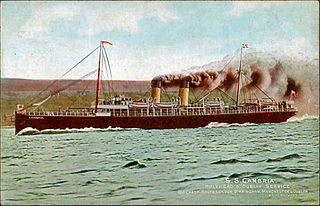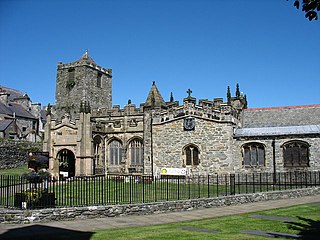
The City of Dublin Steam Packet Company was a shipping line established in 1823. It served cross-channel routes between Britain and Ireland for over a century. For 70 of those years it transported the mail. It was 'wound-up' by a select committee of the House of Lords in 1922 and finally liquidated in 1930.

The North Wales Mineral Railway was formed to carry coal and ironstone from the mineral-bearing area around Wrexham to the River Dee wharves. It was extended to run from Shrewsbury and formed part of a main line trunk route, under the title The Shrewsbury and Chester Railway. It opened in 1846 from Chester to Ruabon, and in 1848 from Ruabon to Shrewsbury. It later merged with the Great Western Railway.
TSS Hibernia was a twin screw steamer passenger vessel operated by the London and North Western Railway from 1900 to 1914. She was renamed HMS Tara on requisition by the Admiralty in 1914, and sunk in action in November 1915.

TSS Cambria was a twin screw steamer passenger vessel operated by the London and North Western Railway from 1897 to 1923.
TSS North Wall was a twin screw steamer cargo vessel operated by the London and North Western Railway (LNWR) from 1893 to 1904.
PS Sea Nymph was a paddle steamer passenger vessel operated by the London and North Western Railway from 1856 to 1876.
PS Telegraph was a paddle steamer passenger vessel operated by the London and North Western Railway from 1859 to 1874.
PS Scotia was a paddle steamer passenger vessel operated by the Chester and Holyhead Railway from 1847 to 1858, and the London and North Western Railway from 1859 to 1861.
PS Anglia was a paddle steamer passenger vessel operated by the Chester and Holyhead Railway from 1847 to 1859 and the London and North Western Railway from 1859 to 1861.
PS Alexandra was a paddle steamer passenger vessel operated by the London and North Western Railway from 1863 to 1889.
PS Lily was a paddle steamer passenger vessel operated by the London and North Western Railway from 1880 to 1900.
PS Violet was a paddle steamer passenger vessel operated by the London and North Western Railway from 1880 to 1902.
PS Eleanor was a paddle steamer cargo vessel operated by the London and North Western Railway from 1881 to 1902.
TSS Olga was a steam turbine cargo vessel operated by the London and North Western Railway from 1887 to 1908.
TSS Rosstrevor was a steam turbine passenger and cargo vessel operated by the London and North Western Railway from 1895 to 1923, and the London, Midland and Scottish Railway from 1923 to 1926.
PS Ocean was a paddle steamer built for and operated by the St. George Steam Packet Company from 1836, then the Cork Steamship Company and then the Chester and Holyhead Railway from 1853 to 1859 and the London and North Western Railway from 1859 to 1862.
PS Hercules was a paddle steamer vessel operated by the St. George Steam Packet Company from 1836, and then the Chester and Holyhead Railway from 1853 to 1859 and the London and North Western Railway from 1859 to 1862.
SS Hodder was a freight vessel built for the Lancashire and Yorkshire Railway in 1910.





